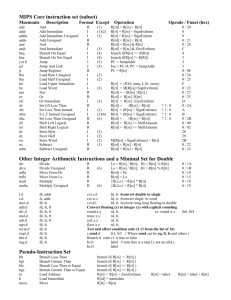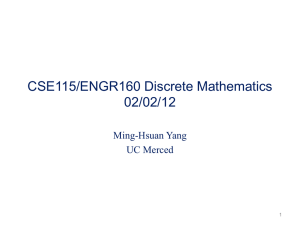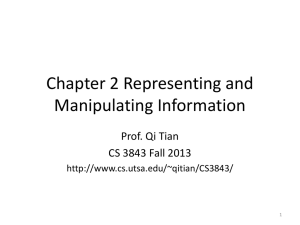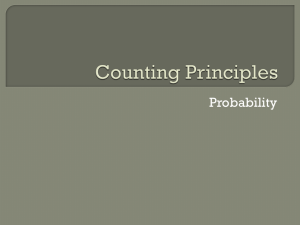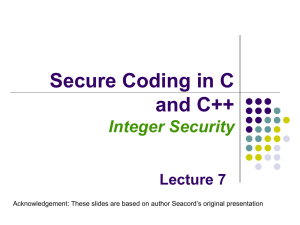Regular Expressions
advertisement
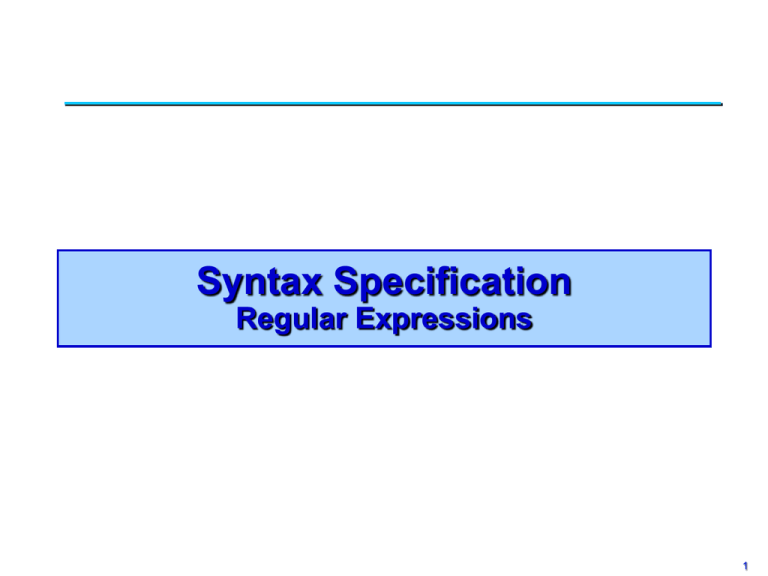
Syntax Specification
Regular Expressions
1
Phases of Compilation
2
Syntax Analysis
• Syntax:
– Webster’s definition: 1 a : the way in which linguistic
elements (as words) are put together to form constituents
(as phrases or clauses)
• The syntax of a programming language
– Describes its form
» i.e. Organization of tokens (elements)
– Formal notation
» Context Free Grammars (CFGs)
3
Review: Formal definition of tokens
• A set of tokens is a set of strings over an alphabet
– {read, write, +, -, *, /, :=, 1, 2, …, 10, …, 3.45e-3, …}
• A set of tokens is a regular set that can be defined by
comprehension using a regular expression
• For every regular set, there is a deterministic finite
automaton (DFA) that can recognize it
– i.e. determine whether a string belongs to the set or not
– Scanners extract tokens from source code in the same way
DFAs determine membership
4
Regular Expressions
• A regular expression (RE) is:
– A single character
– The empty string,
– The concatenation of two regular expressions
» Notation: RE1 RE2 (i.e. RE1 followed by RE2)
– The union of two regular expressions
» Notation: RE1 | RE2
– The closure of a regular expression
» Notation: RE*
» * is known as the Kleene star
» * represents the concatenation of 0 or more strings
– Non-null enumeration
» Notation: RE+
» represents all non-null concatenations of RE (1 or more times)
5
Regular Expressions Basics
Let alphabet ={a,b} (means a and b are its only letters)
a*=(, a, aa, aaa, ...}
(ab)*=(, ab, abab, ababab, ...}
a b=(a, , b, bb, bb, ...}
(a b)*= all strings containing a’s and b’s
(a*b*)*=(ab*)*= all strings containing a’s and b’s
a*b*={aibj| i >=0, j>=0)
6
Building Regular Expressions
Regular Expressions as Language
• * while loop
–iterates 0 or more times
• concatenation uv
–sequential; first u, then v
• uv
OR
–select from one or the other or both
7
Description Regular Expression
Let ={a,b} – all expressions over this alphabet
Strings with
• exactly one a
b*ab*
• exactly two a’s
b*ab*ab*
• one or more a’s
(b*ab*)* or (a b)*a (a b)*
• even number of a’s (b*ab*ab*)*
• even number of a’s and exactly one b
•
(aa)*b(aa)* (aa)*ab(aa)*a
• odd number of a’s (b*ab*ab*)*b*ab*
• that don’t contain aa
(b ab)*( a)
8
Regular Expression Description
Same alphabet
• (aa)*
even number of a’s
• (a b) (a b) (a b) (a b)
all strings of length 4
• ((a b) (a b) (a b) (a b))*
strings of length divisible by 4
• (aa)* ((a b) (a b) (a b) (a b))*
strings of a’s of length divisible by 4
9
Token Definition Example
• Numeric literals in Pascal
– Definition of the token unsigned_number
digit 0 | 1 | 2 | 3 | 4 | 5 | 6 | 7 | 8 | 9
unsigned_integer digit digit* | digit+
unsigned_number unsigned_integer ( ( . unsigned_integer ) | )
( ( e ( + | – | ) unsigned_integer ) | )
• Recursion is not allowed in Regular Expressions!
10
Exercise
digit 0 | 1 | 2 | 3 | 4 | 5 | 6 | 7 | 8 | 9
unsigned_integer digit digit*
unsigned_number unsigned_integer ( ( . unsigned_integer ) | )
( ( e ( + | – | ) unsigned_integer ) | )
• Regular expression for
– Decimal numbers
number …
11
Exercise
digit 0 | 1 | 2 | 3 | 4 | 5 | 6 | 7 | 8 | 9
unsigned_integer digit digit*
unsigned_number unsigned_integer ( ( . unsigned_integer ) | )
( ( e ( + | – | ) unsigned_integer ) | )
• Regular expression for
– Decimal numbers
number ( + | – | ) unsigned_integer ( ( unsigned_integer ) | )
12
Exercise
digit 0 | 1 | 2 | 3 | 4 | 5 | 6 | 7 | 8 | 9
unsigned_integer digit digit*
unsigned_number unsigned_integer ( ( . unsigned_integer ) | )
( ( e ( + | – | ) unsigned_integer ) | )
• Regular expression for
– Identifiers
identifier …
13
Exercise
digit 0 | 1 | 2 | 3 | 4 | 5 | 6 | 7 | 8 | 9
unsigned_integer digit digit*
unsigned_number unsigned_integer ( ( . unsigned_integer ) | )
( ( e ( + | – | ) unsigned_integer ) | )
• Regular expression for
– Identifiers
identifier letter ( letter | digit | )*
letter a | b | c | … | z
14
